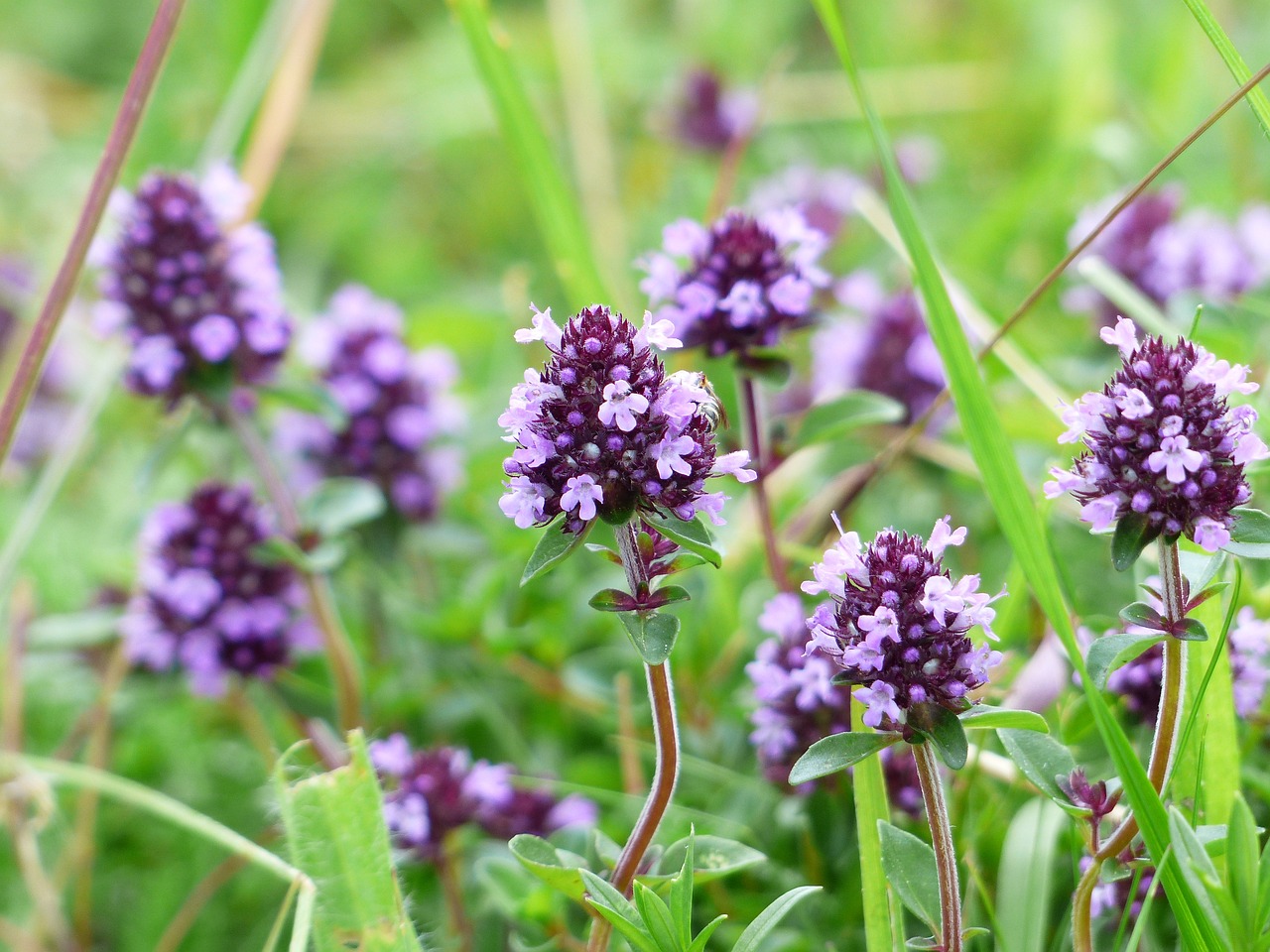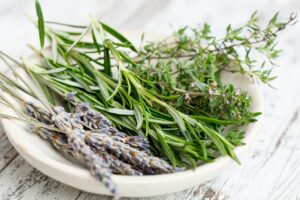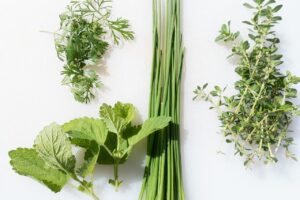Thyme
Overview
Thyme, known as Thymus vulgaris, is a fragrant, small perennial herb that thrives in dry, sunny environments. It’s esteemed for its culinary role, lending a bold flavor to a myriad of dishes. The hardy nature of thyme also makes it a charming addition to gardens, persisting through various climates and bringing a whiff of the Mediterranean to your doorstep.

Characteristics
Known for its aromatic leaves, culinary use, and hardiness in dry and hot conditions.
Region
Thyme is commonly found and grown in the Mediterranean region.
Natural Habitat
Thyme is usually found in the wild on sunny, well-drained slopes and rocky ground.
Cultivation
Thyme requires full sun, well-drained soil, and regular watering without waterlogging.
Uses and Benefits
Thyme leaves are a versatile and aromatic addition to any kitchen or garden. In cooking, thyme imparts a delightful, earthy flavor that enhances a wide variety of dishes, from savory stews to roasted vegetables5. Its highly aromatic nature not only heightens the sensory experience of your meals but also adds a pleasing scent to your kitchen.
Beyond its culinary uses, thyme is also a valuable addition to your garden. Its evergreen nature provides year-round interest and beauty to your landscape2. Thyme plants offer a lovely, low-growing groundcover that can tolerate light foot traffic, making them an excellent choice for filling spaces between stepping stones or as a border along pathways.
Historically, thyme has been revered for its potential medicinal properties. It has been used to:
- Support respiratory health
- Boost immune system function
- Aid in digestion
- Act as a natural antiseptic
While more research is needed to confirm these benefits, thyme remains a popular choice for those seeking natural remedies.
In summary, thyme is an exceptional herb that offers a myriad of uses and benefits:
| Culinary | Enhances flavors and aromas in various dishes |
| Gardening | Provides evergreen beauty and groundcover |
| Medicinal | Traditionally used to support health and wellness |
Whether you’re a seasoned chef, a passionate gardener, or simply looking to add a touch of natural charm to your life, Thymus vulgaris is a fantastic choice. Embrace the versatility and beauty of this timeless herb and discover the many ways it can enrich your daily life.

Cultivation Tips
To coax the best out of your thyme plant, ensure it basks in plenty of sunlight—the herb adores it.
Embrace well-drained soil for this humble shrub, as it’s crucial for its growth, and water it with a regular, but moderate hand2 4. Thyme thrives in these key conditions:
- Full sun exposure for at least 6 hours daily
- Loose, sandy or loamy soil that drains easily
- Infrequent watering, allowing soil to dry between sessions
Remember, thyme is a trooper in rocky terrains, so don’t fuss if the soil seems less than lush. Its stature is low, but its resilience high, with woody stems that branch out, and its leaves, small yet mighty in taste, grow opposite each other4.
To maintain your thyme plant’s health and vitality, consider these tips:
- Prune regularly to encourage new growth and prevent woodiness
- Mulch around the base to retain moisture and suppress weeds
- Protect from harsh winter weather by covering or moving indoors
Keep a vigilant eye for signs of stress, such as yellowing leaves or wilting. With proper care and attention, your thyme will thrive, lending its aromatic splendor to your garden and dishes alike.
Seasonal Considerations
To coax the best out of your thyme plant, ensure it basks in plenty of sunlight—the herb adores it.
Embrace well-drained soil for this humble shrub, as it’s crucial for its growth, and water it with a regular, but moderate hand2 4. Thyme thrives in the warmer months, so plant it in spring or early summer for the best results. It’s a hardy perennial that can withstand some cold, but harsh winters may require extra protection.
As the seasons change, so do thyme’s needs:
- Spring: Prune back any dead or woody stems to encourage fresh growth. Fertilize lightly, if needed.
- Summer: Enjoy the vibrant growth and harvest leaves as needed. Water consistently during dry spells.
- Fall: Cut back on watering as the plant prepares for winter dormancy. Mulch around the base for insulation.
- Winter: In colder regions, protect thyme with a layer of mulch or bring potted plants indoors.
Remember, thyme is a trooper in rocky terrains, so don’t fuss if the soil seems less than lush. Its stature is low, but its resilience high, with woody stems that branch out, and its leaves, small yet mighty in taste, grow opposite each other4.
Keep a vigilant eye for signs of stress, and with some care, your thyme will thrive, lending its aromatic splendor to your garden and dishes alike.

Issues and Troubleshooting
While Thymus vulgaris is generally a robust and trouble-free herb, it can encounter some issues if its ideal growing conditions are not met. One common problem is overwatering, which can lead to root rot. This occurs when the roots are unable to get the oxygen they need due to excess moisture in the soil 2. To prevent this issue, ensure your thyme is planted in well-draining soil and avoid watering too frequently.
Fungal diseases, such as powdery mildew, can also affect thyme plants, particularly in humid conditions 5. To mitigate this problem:
- Provide adequate spacing between plants to allow for proper air circulation
- Avoid wetting the foliage when watering
- Remove any infected leaves promptly to prevent the spread of the fungus
In terms of pests, keep an eye out for spider mites and aphids, which are attracted to stressed plants 5. Regularly inspect your thyme for signs of infestation, such as stippling on the leaves or the presence of webbing. If you notice any pests, address the issue promptly using appropriate organic or chemical controls, such as:
- Insecticidal soaps
- Neem oil
- Horticultural oils
- Predatory insects (e.g., ladybugs or lacewings)
By providing your thyme with the proper growing conditions and addressing any issues quickly, you can ensure that your plants remain healthy and productive, offering an abundance of aromatic leaves for your culinary creations.
History and Folklore
Thyme, a resilient evergreen shrub, has been a prominent figure in the rich tapestry of history and folklore across southern Europe3. This humble herb has thrived under the warm Mediterranean sun and graced the rustic landscapes of southern Italy since ancient times.
Thyme’s significance extends beyond its culinary uses, as it has been whispered through stories and traditions for centuries. In folklore, thyme was:
- An emblem of bravery, with knights wearing sprigs as a badge of honor
- Believed to carry a mystical veil of protection
- Rumored to be a haven for fairies
- Used as a ward against nightmares when placed beneath pillows
With its remarkable resilience and aromatic gifts, thyme has woven itself into the fabric of folklore, capturing the hearts and imaginations of people throughout the ages. This unassuming herb has not only seasoned countless dishes but has also flavored the stories and traditions that define the rich cultural heritage of southern Europe.
References
1. Thyme – Wikipedia, https://en.wikipedia.org/wiki/Thyme
2. Growing Thyme: Varieties, How to Plant, Care, Problems, and Harvest, https://morningchores.com/growing-thyme/
3. Thymus vulgaris – Wikipedia, https://en.wikipedia.org/wiki/Thymus_vulgaris
4. Thyme | Cooking, Medicinal, Aromatic | Britannica, https://www.britannica.com/plant/thyme
5. Thyme | Diseases and Pests, Description, Uses, Propagation, https://plantvillage.psu.edu/topics/thyme/infos
Nicolas Duval
Nicolas is a passionate advocate for nature and the art of wildcrafting. His dedication shines through in Wildcraftia, a website he meticulously crafted to serve as a haven for nature enthusiasts worldwide. Driven by a deep appreciation for nature’s connection to humanity, Nicolas embarked on his journey in 2011 with SmokableHerbs, a platform showcasing his love for nature’s bounty. Building upon this foundation, he established Smokably, a thriving online store offering premium herbs and blends to a global audience.
